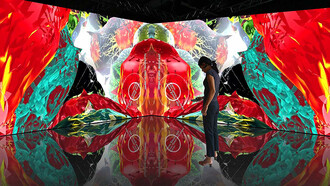Vincent Van Gogh first saw Café Terrace at Night when he was superlatively inspired by Guy De Maupassant’s description of a French café in either Bel Ami or Yvette. His roving eyes found their muse in ‘Place Du Forum’ now renamed as ‘Café Van Gogh’ situated on a quaint street in the village of Arles. The master artist directly painted the vision he saw while sitting on a table. He later wrote a letter to Wilhemina his younger sister, “a starlit night in Paris with the brightly lighted cafes of the Boulevard, and this is approximately the same subject I just painted.”
Seizing our observations in the spur of a moment is famously an impressionist tradition. But Van Gogh differed slightly from the canon. He didn’t officially put a signature but perhaps inadvertently made an impression by bending a real-life subject with his fluid and dreamy imagination rather than creating another replica. He therefore carved a stark distinction between scenery and divine vision.
Medium used is oil on canvas, about 32 x 25 in (81 x 65 cm). Now situated at Kröller-Müller Museum collection, the painting is also titled as Café Terrace on the Place du Forum, Café at Night, or simply Night Café.
The result of a twinkling night sky became a prelude to Van Gogh’s later masterpieces namely Starry Night and Starry Night Over Rhone. Stars on these canvasses are tend to spiral and pull the spectator in an illusionary vortex. The placement of the stars is so accurate that astronomers have literally traced the date when painting was created i.e., 16 or 17 September 1888.
Over the top sulphury yellow lanterns radiating over the terrace, façade, pavement and even the cobblestone streets are accentuated by enchanting luminosity of citron green. On the right, shop windows glow brightly. In Van Gogh’s imagination of night, light appears to be omnipresent in time and space.
There is violet pink tinge for the France’s trademark cobblestone streets which harbor trees with green branches. The nocturnal sky is completely devoid of black. Ironically in a night scene, darkness is a humble side character and not the protagonist. There are little dark doorways on the left and the dark buildings on the right framing the sides of the painting but don’t bearing enough power to distract the people lured by celestial brightness of the café in the middle remain, emulating the charmed dragon flies of jungle. That’s the everlasting Van Gogh effect.
The striking contrast is balanced by use of color gradation. The yellow on the wall gradually turns green. Then that green gradually turns blue at the top of the building. His brushstrokes are pulsating and crystallize excitement and craze an artist feels about his subject. The thick cobblestone lumps are equipped to wobble the carriage while walls and awnings are impressed with leisurely hands. The energetic strokes on the verdures of the tree further animate the view.
A spectator has to dedicate a lot of focus and imaginative energy on a painting to approach the hidden messages, if any. A professor named John Baxter did exactly this and realised there is more to the painting than bunch of people enjoying coffee. Baxter drove the art academia to believe that Van Gogh painted Café Terrace at Night as his own interpretation of the Last Supper. Van Gogh being a follower of Bijschriften-poëzie and son of a protestant minister, possibility is viable. Twelve Apostles followed Jesus. Fascinatingly, only twelve people are sitting in the café centred around a haloed figure with long hairs that could be a waiter or Christ himself. The painting camouflages several semi-visible crosses, the most prominent one is above the Christ-like figure on the muntin of yellow window. The sly figure escaping in the shadows could be Judas Iscariot. Baxter’s proposition is supported by art historian Bill Kloss. UCLA professor Debora Silverman also described Van Gogh’s genre of art as “sacred realism.”
Café Terrace at Night not only immortalizes our attraction for vibrant cafes but also became one of the artist’s many legacies which inspired the German Expressionism of the early 20th century.
Life of Vincent Van Gogh proved that if you can teleport into a dreamy world without boundaries, you are not a madman but a genius born way ahead of time. He showed that by pouring your soul into the present, you can access an alternative universe, where there are abstract mysteries to unravel in many layers of intrigue. Where everything momentary becomes memorable!















